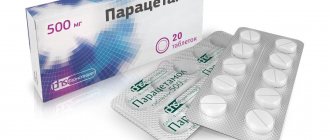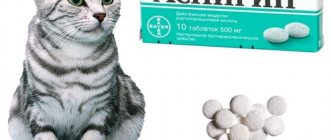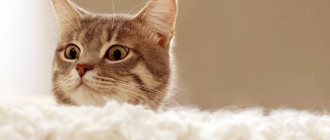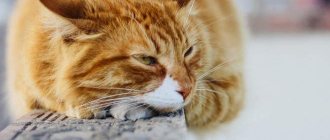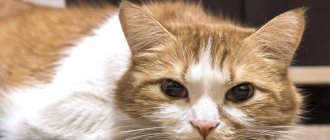10200Pavel
2
Like all animals, cats unfortunately get sick. They have a runny nose, sneezing, and cough. Therefore, animal owners need to know how to rinse their cat’s nose if he is sick. A cold or respiratory tract infection can occur at any time, especially during the autumn-winter and spring-summer transitional climate periods. The cat eats and drinks poorly, becomes lethargic, has difficulty breathing due to nasal congestion, he sneezes and tries to free his nose from snot. The pet will need your help.
Can cats have their nose cleaned?
Sometimes an animal suffers from nasal congestion and cannot do anything about it.
It is recommended for cats to clean their nose in the following cases:
- with a runny nose;
- to remove contaminants.
A runny nose in a cat can be caused by various diseases. It is accompanied by nasal congestion, sneezing, and sometimes other symptoms.
To alleviate the animal's condition, it is important to clear its nose of snot.
The accumulation of dirt in the nasal passages is observed in every animal. This condition is manifested by wheezing, labored and slow breathing.
A cat's nose is an indicator of health
A healthy cat's nose should be fairly cool to the touch, smooth, and maybe even a little slippery. But after sleep, active play or stress, the cat’s nose may become warmer - this is normal. Changes in color may be a sign of poor circulation. For example, a bluish color may be a sign of heart disease or lack of oxygen. Reddish, inflamed nasal mucous membranes may be a symptom of rhinitis, infection, or mechanical irritation.
When a cat's nose is red, it could be a sign of high blood pressure, fever, or allergies. A yellowish color of the nose is a sign of liver or kidney dysfunction.
Causes and symptoms
Sneezing and discharge in an animal can be caused by infectious and non-infectious causes. Depending on this, you need to build treatment. Cats have a very high immunity, and colds - so frequent and even commonplace for humans - are rather an exception to the rule for an animal. Colds and runny noses are more common in homeless cats during periods of cold and rain. Colds occur for several reasons:
- The room is too damp, drafty.
- High humidity.
- Lack of vitamins, poor nutrition.
- Sudden temperature changes.
- The animal is hypothermic or wet (this can happen if the cat, for example, is not dried well after bathing).
Symptoms that will indicate a cold:
- Dry or, conversely, hot nose.
- Hair loss or dullness.
- Great lethargy.
- The cat sleeps for a long time or gets very scared of something that didn’t bother her before.
- Weakness (the animal stands well on its feet, but is apathetic), increased fatigue.
- Decreased appetite.
With a cold, breathing becomes difficult, the snot is clear and not viscous. The cat sneezes and coughs heavily, and the eyes may water. If discharge sticks to the muzzle or crusts appear, this means that the disease is becoming serious and may progress to the pathological stage.
Allergy
If the animal sneezes, tries to constantly rub its eyes and nose, and discharge of a transparent texture appears from the eyes, most likely, we are talking about an allergic rhinitis. The snot in this case is liquid, transparent in color (odorless), and may be accompanied by swelling and dermatitis. Breathing is impaired and itching is likely.
REFERENCE
Cats can develop allergies to a certain product. After consultation with a veterinarian and tests, he will have to be ruled out. There may be allergies to medications, pollen, house plants, and even household items. Most often, the animal reacts to the irritant after several hours, but symptoms can appear several days after encountering the allergen.
Fungi and bacteria
Human ARVI, most often, is not transmitted to cats, but if the disease is caused by certain fungi and bacteria, then both the owner and the pet can become infected with a runny nose.
A bacterial infection is indicated by:
- unpleasant smell of discharge and its yellow-green color;
- accumulation of pus in the corners of the eyes or over the entire surface;
- snot from the nose and tears from the eyes;
- constant sneezing and coughing;
- the animal constantly swallows, this is due to the fact that mucus accumulates in the nasopharynx;
- body temperature rises;
- loss of appetite;
- dehydration;
- prolapse of the third eyelid.
Fungal infections overwhelm animals with weak immunity and often the runny nose becomes chronic. An indicator of a bacterial infection is a crust in the nose, which makes breathing very difficult and snot comes out of the nose.
Foreign bodies
Coughing and sneezing may be caused by a cat swallowing a foreign object in its intestines or esophagus. If this happens, the symptoms will be as follows:
- Profuse salivation.
- If a foreign body is in the throat, then coughing and wheezing appear, the tongue turns blue, and the cat may lose consciousness.
- Constant swallowing.
- Vomiting and belching.
- Complete lack of appetite.
- Bloating.
- Lethargy, apathy, drowsiness.
- Diarrhea, constipation.
- Symptoms of general intoxication.
A runny nose can result from birth defects and injuries. For example, a “cleft palate,” that is, disturbances in the structure of the upper jaw and nasal bones, will cause the cat difficulty breathing and wheezing. Injuries to the jaw or head can result in a cleft palate. The bones can become displaced, and all this together will give the animal a chronic runny nose.
With such pathologies, the discharge does not have an unpleasant odor and most often does not affect the general condition of the cat (if the injury is cured and is not life-threatening). To clarify the causes of chronic runny nose, you should contact your veterinarian. He will identify the pathology and tell you whether it is possible to treat it or eliminate the symptoms.
A runny nose can be an indicator of inflammation that occurs in the nasopharynx or ears. And it will not go away until the initial inflammation is removed.
Why do cats get ear infections?
- Infections.
- Hypothermia.
- Other specific diseases.
Why gums and teeth can become inflamed:
- Malocclusion.
- Lack of vitamins.
- Caries.
- Tartar.
- Injury.
- Irradiation.
- Virus.
- Chemical poisoning.
With inflammation, the following clinical picture is observed:
- breathing quickens;
- discharge from the eyes becomes watery;
- the animal periodically breathes through its mouth;
- sneezing occurs infrequently;
- purulent snot, gray-green, whitish, yellow, sometimes even with traces of blood;
- loss of appetite.
Other problems that cause coughing, sneezing and sniffles include:
- Parasites, for example, worms.
- Tumor of the nasopharynx.
- Neoplasms.
- Chronic diseases.
- Infections.
- Stress.
How to clean snot
Although this is a simple procedure, it is quite unpleasant for the cat. It is important to approach the matter seriously and pay attention to details: preparation, encouragement of the pet, and most importantly, proper restraint of the cat. This procedure is similar to washing a dog’s nose, and if you have already done it, then there will not be any particular difficulties.
It is better to ask someone to help hold your pet, but you can rinse the nose yourself. To begin with, prepare a place, the necessary tools and medicines, as well as treats for reward. You should strictly use only those medications prescribed by your veterinarian.
What you need to prepare in advance
- a syringe with a volume of 1 - 2 ml (can be replaced with a small syringe, it is also very convenient for these purposes, but in this case it will be more difficult to dose the medicine);
- a couple of towels (one for fixing, the second for covering);
- cotton pads, napkins;
- necessary medicine to rinse the nose with;
- treats for encouragement.
It is better to rinse your pet’s nose in the bathroom over the sink so as not to drench the furniture and floor. However, many cats get nervous in such a place, so you can prepare a towel and carry out the manipulation on the table. It is important to provide good lighting to make it comfortable to work. 0.5 - 1 ml of liquid is drawn into the syringe (as indicated by the veterinarian) and the needle must be removed.
After preparation, they take the cat in their arms, be sure to talk to it affectionately and encourage it. If the pet is calm, you can hold it yourself. If the cat is very active or nervous, it is better to wrap it in a second towel and ask a friend for help.
An example of how you can restrain a cat for procedures
How to wash
Holding the pet firmly by the withers and head, the cat is immobilized. It is important to watch the paws; be sure to secure them well. You can sit it on a table, or you can hold it on your lap, whichever is more convenient for the person doing the washing.
First you need to assess the condition of the nose - if there is dirt or crusts on the outside - they are removed with a moistened cotton pad or napkin. After the nose is as clean as possible, proceed to rinsing.
The pet's head is held in a horizontal position; you can tilt it slightly to the side for convenience, but you should not throw it back. With your right hand (for left-handed people, your left hand) take an already filled syringe without a needle and carefully insert its tip into the nostril. You need to insert the needle cone (the thin plastic nose of the syringe onto which a needle is placed, if necessary) very shallowly; it is only important that it fits tightly to the nostril and the liquid enters the nasal cavity and does not flow out through the lips.
Carefully and smoothly pressing the piston, inject the medicine into the pet's nose under gentle pressure. You cannot press the plunger sharply, so as not to “shoot” the medicine in the nose - this can only scare the cat and harm it. Also, do not press jerkily; it is important to calculate the force of pressure.
After introducing the liquid, the excess is wiped off the muzzle. The same is repeated from the second nostril.
Recommendations
Be sure to talk gently and calmly to the pet all the time, praise it exaggeratedly to make it clear that the owner is not causing harm, but is providing assistance.
After the procedure, they are sure to give some goodies to praise and smooth out the unpleasant impression of the manipulation. If you associate nasal rinsing with a pleasant ending, the cat will soon understand the connection and the procedure will be easier next time.
The cat is clearly accustomed to the procedures, as he does not actively resist
How can you perform the procedure?
It is important to check the expiration date of the rinse and its temperature before use. Do not inject hot or cold solution into the nasal passages; you need to rinse it at room temperature or at body temperature.
Basic cleaning rules
It is necessary to clean your pet's nose when it is dirty and from snot.
It's important to do it right.
In order not to scare the animal and quickly carry out the procedure, you should adhere to the following rules:
- the first rinsing is performed under the supervision of a veterinarian;
- It is not allowed to use medications that are used to wash a person’s nasal passages;
- nasal cleaners must be purchased at a veterinary pharmacy;
- You cannot use folk remedies based on salt, iodine or soda, since these components can cause swelling of the nasal mucosa and allergic reactions;
- Each nostril should be rinsed.
Before the procedure, the pet should be immobilized and calmed. To do this, wrap it in a towel or other soft but durable material. After completing the actions, the animal needs to be encouraged - petted and given its favorite dish.
In what cases is the procedure contraindicated?
Nasal lavage is a generally safe and beneficial procedure. Despite this, in some cases it is better to refuse it. Nasal rinsing in cats should not be performed in the following cases:
- formations of malignant and benign etiology in the nasal cavity;
- predisposition to nosebleeds;
- inflammatory process in the middle ear;
- hypersensitivity to the ingredients of the rinse;
- the presence of foreign bodies in the nasal passages.
Not every cat owner can determine whether this procedure will harm her. That is why before carrying out it, it is recommended to consult with a veterinarian. After examining the tailed patient, and perhaps performing diagnostic examinations, the veterinarian will decide on the possibility of performing nasal lavage.
Source
Nasal rinses
The cat can be washed with the following preparations:
- Dioxidine. It is recommended to dilute this medicine with Naphthyzin nasal drops for children in a 1:1 ratio.
- Saline solution. Most often offered in ampoules.
- Special solutions for washing. Gamavit is used to cleanse the upper respiratory tract. Mastiet forte is also considered an effective remedy.
- Furacilin. To prepare the product, you need to dissolve ¼ of the tablet in a glass of warm water.
- Chlorhexidine. It is recommended to dilute the drug with water in a 1:1 ratio.
These products should be purchased from a veterinary pharmacy.
Alternative rinses include:
- aloe juice;
- beet juice.
You can use decoctions of medicinal plants. It is best to use oak bark, chamomile, and string.
It is important to remember that the juices of these plants must be diluted with warm boiled water . These products should be used freshly squeezed and not concentrated.
Water and aloe or beet juice are diluted in a ratio of 1:4.
How can you rinse a cat's nose?
Cats' noses are washed with 0.9% saline solution, 3% boric acid, 1% sea salt solution, 05% tannin solution, 0.5% dioxydin, 1% zinc sulfate solution, 1% soda solution, medicinal preparations (drops).
You can also use decoctions and tinctures of medicinal plants (chamomile, sage, calendula, yarrow), which have anti-inflammatory, wound-healing, and antiseptic properties.
Important! The rinsing solution should always be at room temperature.
To rinse the cat's nasal cavity, it is strictly forbidden to use overly concentrated saline solutions (saline solution), preparations containing iodine, alcohol, or other components that have an aggressive effect on the mucous membranes of the nasal passages. Otherwise, you can provoke a burn, swelling of the nasal mucosa, and an acute inflammatory reaction.
Cats, like other animals, are prone to various diseases. And a slight draft or the slightest speck can lead to serious inflammation of the eyes. Cats experience runny nose and conjunctivitis, which require treatment. Is it possible for a cat to use Furacilin for washing the eyes and nose? This is a frequently asked question.
Anandin
One of the most common drugs for the treatment of rhinitis. In addition, the medicine can be used in the treatment of diseases of the eyes and ears.
The composition includes glucaminopropylcarbacridone, which has a pronounced anti-inflammatory effect. In addition, the active substance enhances the local and general immune status of the body. The following indications for use are distinguished:
- Rhinitis of bacterial and viral origin.
- The product can be used as an auxiliary medicine in the treatment of fungal inflammation of the nasal cavity (Anandin alone cannot cope with fungi).
- In addition, the medicine helps to cope with rhinitis of allergic etiology.
There are usually no difficulties when using the drug:
- For mild rhinitis, drop two drops into each nostril twice a day. The period of use is approximately a week.
- In the case of rhinitis with moderate and severe intensity of the inflammatory process, the dose can be increased to three or four drops in each nostril, the frequency of use can be increased to three times a day. The duration of use in this case should not exceed two weeks.
Treatment
Since a runny nose often becomes only an indicator of a viral infection or other inflammation in the body, it will be necessary to treat not so much it as the root cause. It is not always possible to independently find out the true source of the disease.
Therefore, it is very important to consult a veterinarian, carry out a diagnosis and follow the treatment plan.
It will be very difficult to cure a stray cat from a runny nose if he is not provided with comfortable conditions: warmth, food, vitamins and scheduled medications.
Useful video on how to put drops in a cat's nose:
Colds and rhinitis
If your cat's cold cannot be treated at home, then you need to seek help from a veterinarian. The clinic will examine the cat and prescribe the necessary medications. It is not recommended to use medications without a prescription from a specialist. Typically treatment includes:
- Taking antipyretics if the temperature persists.
- Expectorants.
- Antibiotics.
- Vitamins.
- Droppers (to avoid dehydration).
- Maxidin. Drop into the nose to stimulate the immune system.
- Anandin. Antiviral and immune system stimulant.
- Naphthyzin together with Dioxidine. Nasal rinsing.
- Galazolin. Drops to ease breathing.
One drop of the drug is instilled into each nostril. The course is from five days to a week. You can rinse your nose with zinc sulfate (2%), boric acid (3%), a mixture of Methanol and fish oil.
Other means: “Maksidin”, “Derinat”.
Allergic runny nose
Irritation in animals is caused by food and non-food allergens. The most common of them:
- Beef or pork.
- Chicken, chicken eggs.
- Cow's milk.
- Corn, wheat (other cereal grains).
- Potato.
- Carrot.
- Dust.
- Mold.
- Hygiene products, household chemicals.
- Irritant from a flea collar.
To cure an allergy, you need to accurately and in detail describe the symptoms to the doctor; it is advisable to note what exactly the cat reacts to and for how long. They do a blood test and scraping. Antihistamines and corticosteroids are most often used for treatment.
The house needs to be treated with insecticides, and the animal must be isolated from the allergen that causes the reaction. If you cannot immediately find out what exactly is causing the disorder, you must remove as much as possible all household chemicals, medications, cosmetics, etc. The room must be cleaned and ventilated frequently.
If the allergy is accompanied by itching, the doctor will prescribe a special ointment, shampoo or gel. Sometimes steroid hormones and immunotherapy are prescribed (a small amount of the allergen is injected into the blood so that the body gets used to it).
If you have an eating disorder, you need to follow a diet. For example, use hypoallergenic food. When the symptoms go away, the previous foods are returned to the diet, checking the animal’s reaction. If the runny nose recurs, food allergens should be categorically removed from the animal’s food forever.
Viral runny nose
Among viral infections, rhinotracheitis, calicivirosis, mycoplasmosis, chlamydia and other infections cause a runny nose. And although they differ, the treatment regimen is approximately the same for everyone. The main thing is to contact specialists in time. You cannot cure a viral infection on your own; only a veterinarian can prescribe the exact dosage and duration.
Serum or globulin is used to create immunity - the drug VITAFEL, vitamins and probiotics, replacement therapy.
Antibiotics are required. They are drunk for at least five days, most often from a week to ten days, one to three times a day.
Treatment at home
For treatment at home, nasal drops are used, for example, children's nasal drops - one in each nostril daily. You can rinse your nose with a hypotonic solution: a teaspoon of sea salt in warm water (half a glass). The mucous membrane is also washed with a solution of tannin (0.5%), soda (1% solution). Streptocide powder is blown into the nasal cavity or two drops of ecmonovocillin are dripped into each nostril (it is diluted with saline 1:2).
From folk remedies, rinsing with beet juice is suitable: 1 part juice to 3 parts water. Aloe juice from the cut is collected into a pipette and dripped for three days. To rinse, you can use boric acid (draw the liquid into a syringe without a needle, drop it into the nostril).
You can do inhalation: take a bowl of hot water, drop eucalyptus or other oil into it, and place the container near the animal.
Cleaning your nose when you have a runny nose
Cleaning your cat's nasal passages will help relieve your pet of a runny nose. It is carried out according to the following algorithm src=»https://nashakisa.ru/wp-content/uploads/2019/01/foto-9-1-360×270.jpg» class=»aligncenter» width=»360″ height= "270"[/img]
- The rinsing solution is carefully drawn into the syringe. The dosage should not exceed 0.5 ml. The needle is removed from the syringe. You can also use a pipette.
- The animal is wrapped in thick cloth or a towel to avoid scratches. To calm your pet, it is also recommended to attach a clothespin to the withers.
- The end of the syringe is carefully inserted into the nasal passage.
- The liquid is introduced slowly. Gently press the syringe plunger.
- You need to rinse each nostril with the solution.
- After this, wipe off the discharge with a cotton pad. It can be replaced with a small cotton wool turunda.
For a runny nose, use saline or other means. An effective procedure is rinsing with Chlorhexidine or Furacilin.
Usually a cat’s rhinitis goes away after 1-2 manipulations.
If other symptoms of the disease develop or the washing procedure is ineffective, it is necessary to show the cat to a veterinarian.
Standard scheme for eliminating nasal congestion
Of course, later it will be important to understand exactly why the cat’s nose is not breathing.
But first you need to make sure that the animal does not suffocate, while simultaneously slowing down the development of the inflammatory process:
- First, the cat’s nose needs to be rinsed (the technology for performing this procedure is described below). If everything is done correctly, using the right medications, the animal’s nasal passages will be cleared of crusts and thickened exudate, and the swelling of the mucous membranes will subside.
- In cases where the inflammation is not advanced, rinsing with chamomile decoction is recommended. This simple remedy has a good antiseptic and anti-inflammatory effect.
- To consolidate the effect of washing for a long time, it is advisable to use some kind of medicinal drops. We will discuss below exactly what medications can be used to treat cats.
But even in cases where the owner was able to alleviate the pet’s condition at home, there is no need to postpone a visit to the clinic. Often, rhinitis in a cat is not a harmless consequence of a cold, but a symptom of dangerous viral infections. If you delay in contacting a specialist, the consequences can be very serious (even the death of the animal).
We suggest you read: What food can you feed Scottish Fold kittens?
Creating a comfort zone
If your cat has an unfortunate runny nose, you should not quarantine the entire territory of the apartment. At a minimum, it is necessary to provide your furry pet with a soft and dry bed, as well as peace and warmth.
You can speed up your cat's recovery by taking some simple steps:
- Protect the sick animal from communicating with its relatives so that other cats do not get sick either;
- Place a humidifier in the room where your cat is most present. This will help create increased humidity and make breathing much easier for the animal;
- Make sure that there is always a bowl of clean water next to the cat. This will help prevent dehydration, which is extremely undesirable for a sick pet;
- Clean your eyes and nose periodically with moistened cotton swabs. This will make it possible to prevent the formation of crusts on the eyes and nose. And also watch for changes in the color of the discharge; if it turns green, then you should show the animal to a doctor;
- To prevent the formation of a crust and avoid increased dryness in the nose, it is necessary to lubricate the area around it with baby oil or Vaseline;
- You can try children's drops for runny nose, which need to be dripped once a day into one nostril. The next day, also 1 drop, but in the other nostril. Continue treatment for 5-7 days.
Treatment
Since a runny nose often becomes only an indicator of a viral infection or other inflammation in the body, it will be necessary to treat not so much it as the root cause. It is not always possible to independently find out the true source of the disease.
Therefore, it is very important to consult a veterinarian, carry out a diagnosis and follow the treatment plan.
It will be very difficult to cure a stray cat from a runny nose if he is not provided with comfortable conditions: warmth, food, vitamins and scheduled medications.
Useful video on how to put drops in a cat's nose:
Colds and rhinitis
If your cat's cold cannot be treated at home, then you need to seek help from a veterinarian. The clinic will examine the cat and prescribe the necessary medications. It is not recommended to use medications without a prescription from a specialist. Typically treatment includes:
- Taking antipyretics if the temperature persists.
- Expectorants.
- Antibiotics.
- Vitamins.
- Droppers (to avoid dehydration).
Drugs used:
- Maxidin. Drop into the nose to stimulate the immune system.
- Anandin. Antiviral and immune system stimulant.
- Naphthyzin together with Dioxidine. Nasal rinsing.
- Galazolin. Drops to ease breathing.
One drop of the drug is instilled into each nostril. The course is from five days to a week. You can rinse your nose with zinc sulfate (2%), boric acid (3%), a mixture of Methanol and fish oil.
Other means: “Maksidin”, “Derinat”.
Allergic runny nose
Irritation in animals is caused by food and non-food allergens. The most common of them:
- Beef or pork.
- Chicken, chicken eggs.
- Cow's milk.
- Corn, wheat (other cereal grains).
- Potato.
- Carrot.
- Dust.
- Mold.
- Hygiene products, household chemicals.
- Irritant from a flea collar.
To cure an allergy, you need to accurately and in detail describe the symptoms to the doctor; it is advisable to note what exactly the cat reacts to and for how long. They do a blood test and scraping. Antihistamines and corticosteroids are most often used for treatment.
The house needs to be treated with insecticides, and the animal must be isolated from the allergen that causes the reaction. If you cannot immediately find out what exactly is causing the disorder, you must remove as much as possible all household chemicals, medications, cosmetics, etc. The room must be cleaned and ventilated frequently.
If the allergy is accompanied by itching, the doctor will prescribe a special ointment, shampoo or gel. Sometimes steroid hormones and immunotherapy are prescribed (a small amount of the allergen is injected into the blood so that the body gets used to it).
If you have an eating disorder, you need to follow a diet. For example, use hypoallergenic food. When the symptoms go away, the previous foods are returned to the diet, checking the animal’s reaction. If the runny nose recurs, food allergens should be categorically removed from the animal’s food forever.
Viral runny nose
Among viral infections, rhinotracheitis, calicivirosis, mycoplasmosis, chlamydia and other infections cause a runny nose. And although they differ, the treatment regimen is approximately the same for everyone. The main thing is to contact specialists in time. You cannot cure a viral infection on your own; only a veterinarian can prescribe the exact dosage and duration.
Serum or globulin is used to create immunity - the drug VITAFEL, vitamins and probiotics, replacement therapy.
Immunostimulants:
- Roncoleukin.
- Derinat.
- Neovir.
- Gamavit.
Antibiotics are required. They are drunk for at least five days, most often from a week to ten days, one to three times a day.
- Macropen.
- Baytril.
- Neopen.
- Cefazolin.
- and others.
Treatment at home
For treatment at home, nasal drops are used, for example, children's nasal drops - one in each nostril daily. You can rinse your nose with a hypotonic solution: a teaspoon of sea salt in warm water (half a glass). The mucous membrane is also washed with a solution of tannin (0.5%), soda (1% solution). Streptocide powder is blown into the nasal cavity or two drops of ecmonovocillin are dripped into each nostril (it is diluted with saline 1:2).
From folk remedies, rinsing with beet juice is suitable: 1 part juice to 3 parts water. Aloe juice from the cut is collected into a pipette and dripped for three days. To rinse, you can use boric acid (draw the liquid into a syringe without a needle, drop it into the nostril).
You can do inhalation: take a bowl of hot water, drop eucalyptus or other oil into it, and place the container near the animal.
Cleaning from dirt
Veterinarians say that the animal's nasal passages clear themselves, so intervention is usually not required. But if your cat is acting restless or exhibiting other symptoms, she should have her nose cleaned.
The washing steps should be as follows:
- Draw boiled water at room temperature into a syringe or pipette.
- Immobilize the pet using a clothespin at the withers or wrapping it in thick material.
- With one hand, support the animal by the head, and with the other, pour in the solution in a thin stream. Liquids are drawn into the syringe no more than 0.5 ml.
- After rinsing one nostril, the manipulation is repeated with the other.
- Remove dirt with a cotton swab.
It is important to calm the animal . To do this, it is recommended to stroke it. Upon completion of the procedure, the pet must be rewarded by giving it a favorite treat.
How to rinse your cat's nose yourself
Rinse the cat's nose, sequence of actions:
- Calm your pet by restraining the cat well. To prevent your cat from scratching, wrap her in a soft towel. It is often recommended to use a clothespin or paper pin to immobilize cats. Tilt the animal's head slightly. Place the clothespin on the skin on the back of your neck.
- For rinsing, use a small syringe with a soft tip, a pipette, or a disposable syringe without a needle. It is more convenient to use insulin syringes for rinsing the cat's nose.
- For example, draw the required amount of medicinal solution into a syringe and slowly, lifting the cat’s face gently, not quickly, inject the drug into one nostril in a dose of no more than 0.5 mg (half the mark on the syringe).
- Calm the cat and continue the procedure after a while.
- After rinsing the nose, praise your pet and reward him with a treat for good behavior and patience. The cat should forget about the stress he suffered as quickly as possible. It is on how correctly the first procedure was carried out that the pet’s further perception of medical manipulations will depend.
Depending on the indications, wash the cat’s nose several times a day (3-5 times). The procedure is carried out until the cat is completely healed and respiratory function is normalized. On average, the course of treatment takes 4-7 days.
We focus on food
- One of the most common treatments is appetite stimulation. The essence of the method is that an animal with a clogged nose cannot smell food, so its craving for food sharply decreases and, over time, a loss of strength occurs.
- You can help restore the vital energy that is so necessary to fight the insidious infection by offering your cat something that smells very appetizing. It could be delicious fish or meat, or some special dish that your pet likes.
- If your pet is accustomed to cat food, then offer him a canned version, which, unlike dry food, has a more pronounced aroma. If the animal does not want to eat, then you can lubricate the cat’s nose with sour cream or pate. The focus on cleanliness should work here; the cat will definitely lick its nose and, perhaps, taste the deliciousness.
Features of the procedure in newborn kittens
A newborn kitten will also occasionally need to clean out postpartum discharge from her nose. Sometimes the procedure needs to be done in order to free the baby’s nostrils from contamination.
The kitten also has a runny nose, which prevents it from breathing. Therefore, the nasal passages should be cleared of snot.
Since kittens' nasal passages are very small, they should be cleaned carefully.
The procedure is characterized by its own characteristics:
- washing must be done with a pipette;
- do not use a syringe;
- the kitten is immobilized with a towel;
- approximately 0.2-0.3 ml of solution is injected;
- the liquid should not be too cold or hot;
- the solution is poured into each nasal passage.
You can clean your kitten's nose with saline solution, Chlorhexidine or boiled water.
How to put Furacilin in your nose
It often happens that when a cat is hypothermic, a colorless liquid is released from the nose, this is rhinitis. The first step is to consult a veterinarian. If he prescribes rinsing the nose with Furacilin solution, do it like this:
- Furacilin should be warm for rinsing.
- To rinse the nose, you can use a syringe (without a needle), but for the safety of the cat it is better to use a pipette.
- If the cat is restless, you should use outside help and hold the animal.
- Half a cube (0.5 ml) of solution for one nostril will be enough. Do the procedure three times a day, for 3-5 days.
If furatsilin is in tablets, it is diluted in a ratio of 100 g. water, one fourth of the tablet. To make the tablet dissolve faster, crush it to a powder and pour boiling water over it.
